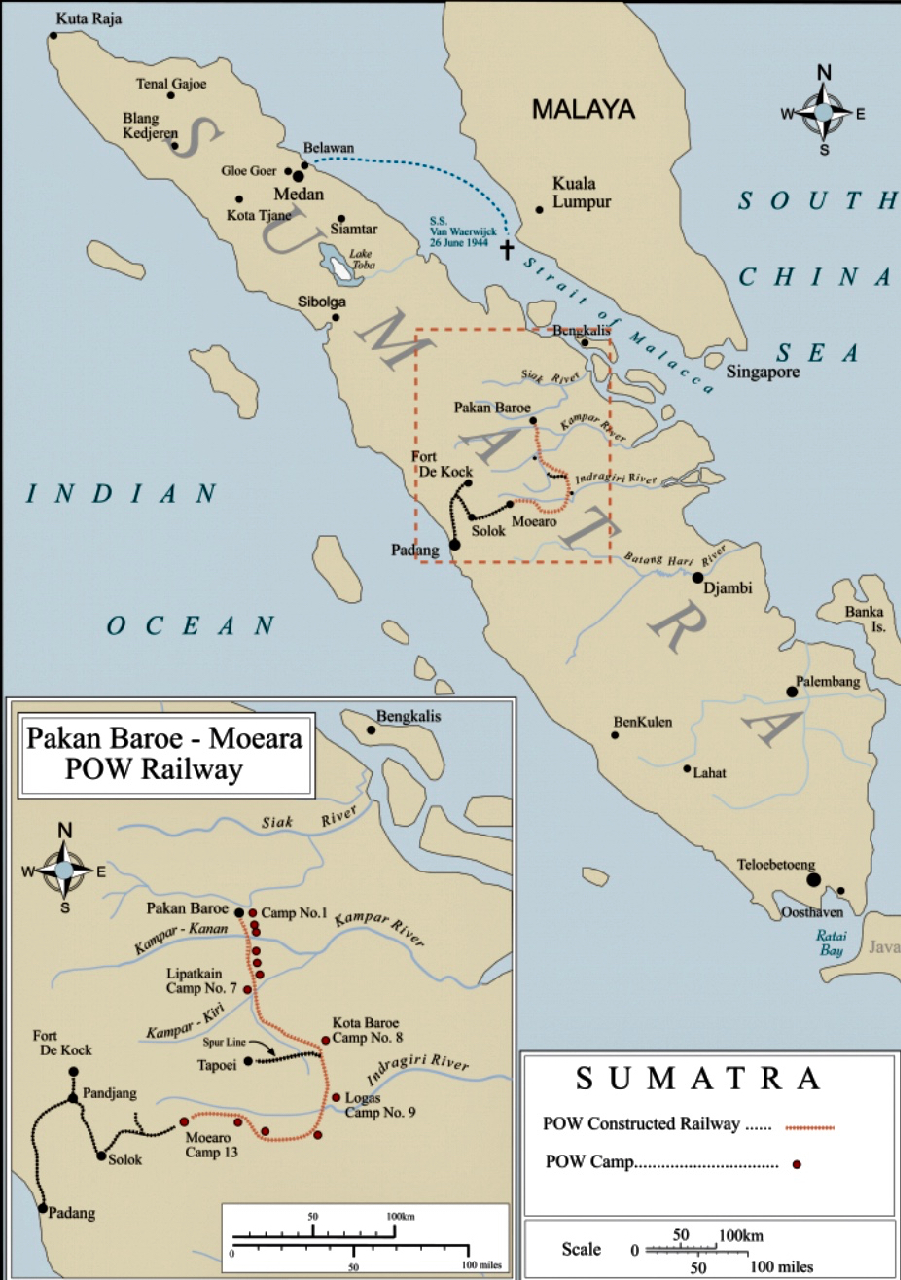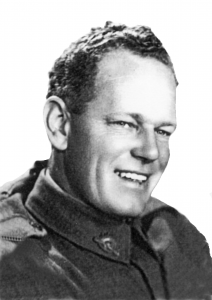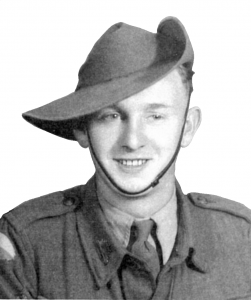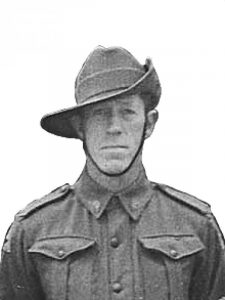Seven 2/4th men commenced work on Sumatran Railway. Richard Annear, Arthur Magill, Quinn & Squance who were joined by three 2/4th POWs from Java: Banks, Booth & McAskil. (Booth & McAskil died of illness 1945)
Ted Hopson died Atjeh Party.
Burgess, Semple and Harold Smith remained behind in Singapore with illness or injuries following sinking of POW Transport ship SS Harujkiju in 1944.
Total five 2/4th men survived working on Sumatran Railway & were recovered.

Repatriation of Australian POWs from South East Asia began 18 August 1945 and by 10 October 18,500 men had been evacuated from Thailand.
On 16 September 1945 Major Windsor AAMC from 2/14th Australian General Hospital was flown by a Douglas C47 to Pakan Baroe, to assess the situation of POWs in Sumatra. He immediately reported back that although morale was good, conditions under which the 169 Australian POWs were living were unbearable. The hospital was in poor condition and immediate evacuation by air was recommended.
It was thus decided to make Sumatra the No. 1 priority ahead of Thailand. It is worthwhile to remember the 220 kilometre railway project had just been completed. The POWs were emaciated and terribly ill.
At Pakan Baroe all motor transport, mostly in a state of disrepair was mustered to transport the worst cases from hospital to the airfield 5 kilometres away. By 16 September the equivalent of 3 planeloads of POWs were at the airfield awaiting evacuation to Singapore. When the rescue planes arrived at Pakan Baroe and saw the state of men who had been working on the Sumatra railway, they were reduced to tears.
Prior to Japan’s surrender, the POWs were forced to eat fungus and bark from trees just to keep themselves alive. At this time there was little to be had in the way of food supplies for anybody, including the Japanese.
The first aircraft returned to Singapore on the same day but did not return to Sumatra for the second evacuation flight. The RAAF had been directed that no further aircraft were to be sent to Pakan Baroe. Windsor immediately ordered a C47 aircraft return to Sumatra to at least evacuate one more load of sick men, who otherwise would have been forced to remain out in the open at night because they were too frail to return the 5 kilometres to the Hospital Camp.
Further enquiries and a conference about this event revealed the British DDMS cancelled all flights believing there was not sufficient accommodation on Singapore!
It was pointed out the fragile condition of not only Australian POWs, but the British too and it was imperative they be airlifted to Singapore as soon as possible. The pilots arrived 19 September with ‘Endeavour’ and took the WA survivors, leaving 7 others to fly in the Dakota. The mercy flights continued evacuating all the British and Australian POWs from Sumatra.
The Australians on arrival at Singapore were admitted to 2/14th Australian General Hospital for immediate care. Several men from 2/4th were flown directly from Singapore to Guildford Airport a week later on 24 September, 1945.
These men were Richard ‘Win’ Annear, Noel Banks and ‘Squasher’ Squance.
Right: Noel Banks
Below: Richard Annear

 Left: Squance
Left: Squance
Alf Burgess was rescued from Harukiku sinking and remained Singapore from 28 June1944 – he was recovered from Singapore and returned onboard 1st Netherlands Military Hospital ship Oranje.
Arthur Magill worked on the Sumatra Railway from where he was recovered. Taken to Singapore after the war ended, he returned onboard Arawa.
Cecil Quinn worked on the Sumatra Rail. Was recovered and flown toSingapore to returned home on the Highland Chieftain.
There were two deaths in Sumatra – Robert McAskil died cardiac beri beri working on the railway at 106 km point on 28 March 1945, and Harold Vernon Booth died of beri beri on 15 April 1945 at No. 2 Hospital Camp, Tengkirang about 5 kilometres south of Pakan Baroe.
Ted Hopson had died earlier, during road construction.
 Harold Booth
Harold Booth Robert McAskil
Robert McAskil




Below: Press photo of Cliff Squance, emaciated and very ill as he landed at Guildford Airport – being greeted by then Premier, Sir James Mitchell.


Note: D A C Quinn WX5054 remained in Singapore throughout war – not to be confused with Cecil George Quinn WX9285 who was recovered from Sumatra, but sailed from Singapore to Sydney by ‘Highland Chieftan’, then Sydney-Melbourne-Perth by troop train.
Only three of the very sick men from Sumatra flew on this plane – Annear, Banks and Squance. Magill sailed from Singapore on ‘Arawa’ to Sydney, train to Melbourne, ‘Strathmore’ to WA.

Avro York (Serial No. MW140), “Endeavour”, flew to Australia in 1945 to become the personal aircraft of HRH The Duke of Gloucester, Australia’s Governor-General. It was operated by the Governor-General’s Flight from 1945 to 1947; it was the RAAF’s only York.
You can view POWs at Pakan Baroe Sumatra at end of war
You can see former POWs arrive Singapore from Sumatra
Major Saggers, Lt. O’Sullivan, Lt. Mentiplay and several other Changi resident 2/4th men managed to get on this flight – as Saggers wrote – he found there were several seats available and asked for officers who would like to fly back to Perth.
I wish to acknowledge and thank Lt Col (Ret’d) Peter Winstanley OAM RFD (JP) for his work in ‘Articles about prisoners of war of the Japanese 1941-1945.’ The following has been copied from this Book.
The following dates are from a diary of Robert Lewis (Bob) Miller an Australian serving with Royal navy who became POW near Banka Island 18 Feb 1942
13 Aug 1945 Men dying fast from starvation
14 Aug 1945 Last outside working parties
15 Aug 1945 Japs and Kempetai ‘big eats’ (I believe this means they feasted well)
16/17/18/19 Aug 1945 Lull – no work parties. We are still wondering about the finish
20 Aug 1945 12.30 rice increased to 550 grams. BIGGEST ration in camp for two years. Japs still quiet about truce.
21 Aug 1945 Yasme – still in dark – 4 ? arrived in camp.
22 Aug 1945 Official news of truce – had fish, beans, gula. Quiet celebration – all camp restless – could not sleep. Pilots amazed us with news of outside.
23 Aug 1945 – Guards kept to guardroom – own police on gate – clothing, shirt, shorts, socks, blanket issue by Japs. Remove dying men to hospital.
24 Aug 1945 – issue of boots, fondouche, towel, soap. Greens and meat increase and soya cake. Still working as blacksmith – feeling well – cannot realise war is over.
25 Aug 1945 – coffee and gula 1st issue. Camp sick from overeating. Bad stomach cases. Pigs being killed. Camp improved. Mental cases.
26 Aug 1945 – Rumaweel convoys camp all afire. 1st issue of Senangat – 20 per man. One Chinese killed during night – one injured my MP.
27 Aug 1945 – Ben went to hospital – bad case. Gula issue 150 grams. Food still the same – 100 grams rice for breakfast, 200 nazi dinner and 250 rice with sauce for supper. Japs very cautious.
28 Aug 1945 12.30 – 3 planes over camp. The first planes we have seen since the war ceased for us. Issue of ? biscuits, toothbrush and soap. Takahashi (Commander of Camp) frightened of trouble – saying ‘Prisones should not walk about in fondouches’. A week ago we could not get clothes to cover our arse. He mentioned ‘we are a great military nation’ – absolute change of opinion.
30 Aug 1945 – ‘Pineapple’ (Jap guard) thumped on the nose.
1 Sep 1945 – still waiting – 12 noon Liberators over dropping stores by parachute – 28 containers consisting of cigarettes, towels, razors. Plane carrying the food crashed after dropping 2 lots. 9 killed. Party out, none survived. Camp very disheartened – 1 container just missing me – frying eggs.
2 Sep 1945 – Capt. Corry demanded military funeral. I am funeral party – grim ordeal. High Jap Officers. Corry made broadcast to world for food and medical gear. Men bartering cigarettes for food. All waiting to get away from this hell hole. Went ashore getting bits of pork and eggs. Bumper nazi for dinner. Awaiting Allied Commission.
3 Sep 1945 – nothing happened. Everybody chocker. Food no good – men swelling up with excess carbohydrate. Men ashore drunk – went around kampong – got one chicken, one duck eggs and fruit. Issue of towels and blankets.
4 Sep 1945 – news of Tokyo – occupation of Padang. Fed up waiting – Chinese contractor being in first lot of fruit and eggs – about time. Issue3 eggs, bananas, 1 pineapple. 4 men dropped with plane with radio, organising internees and POWs. Went ashore with mess – listen to first radio Sydney news and Singapore. Leave unofficial. Japanese very cautious.
6 Sep 1945 – Chinese and Malays very friendly. Issues eggs, meat, stews. Went ashore and listened to radio – very interesting. Jap Officer in cafe. Corry has car. Taken over Palembang radio. Stomach upset with food.
7/8/9 Sep 1945 – radios and cars in camp. First news and papers. Dutch Commission arrived by parachute. 1 Malay, 1 Dutch, 2 ? All men getting very impatient.
10 Sep 1945 – British Commission arrived. Royal Marine Major Jacob – 2 Aussies – great day. Roy Gillam from Mt. Barker. Aussies told us much news of home – all very strange. Had a fine meal – first European meal with Malay merchant (he wanted a favour).
11 Sep 1945 – Planes over dropped cigs and sweets – 20 each. Went ashore. Chinese very good to us. Very.
12 Sep 1945 – Liberators over. 54 containers dropped. Clothing, food and fags. Rackets in full swing. Bad cold – duty – stayed in camp – news of Sumatra – shore patrol armed.
13 Sep 1945 – nothing of interest taking it easy.
14-18 Sep 1945 – going up town – marvellous feeling.
29 Sep 1945 – pilots arrive in camp – take WA survivors – left with 7 others in Dakota for Singapore.
Arrived Changi – lousy – many Aussies made statements as to deaths to RAN.
Note: these are the WA survivors some of whom flew to Guildford on the ‘Endeavour’.
You can watch this 6 minute film of the men being taken on Endeavour. The date is indicated at 15 Sep whereas Bob Miller’s notes say 19th. We find the Sumatra dates very conflicting and difficult to verify.
Translations:
fondouches – I believe this is same as ‘jap happys’
gula – palm sugar from from flowers of plants, coconut palm.
yasme – rest day.

